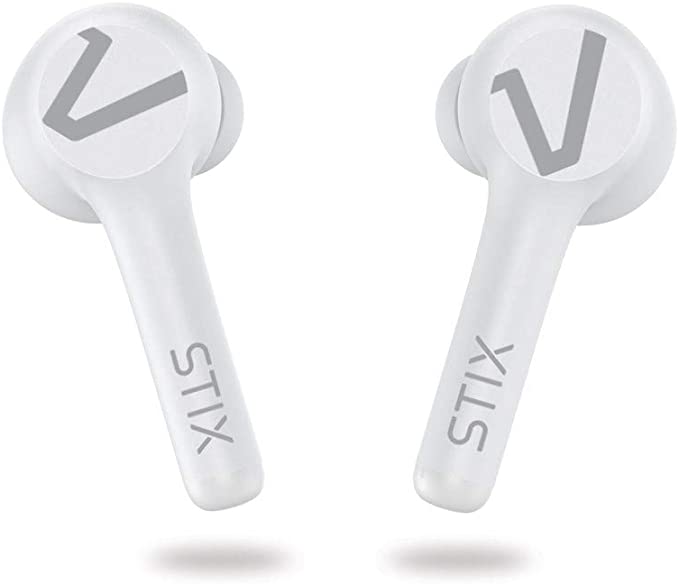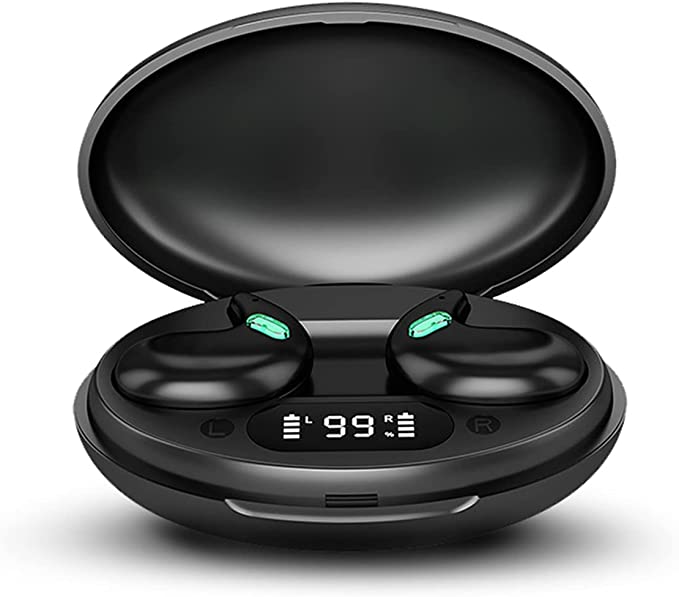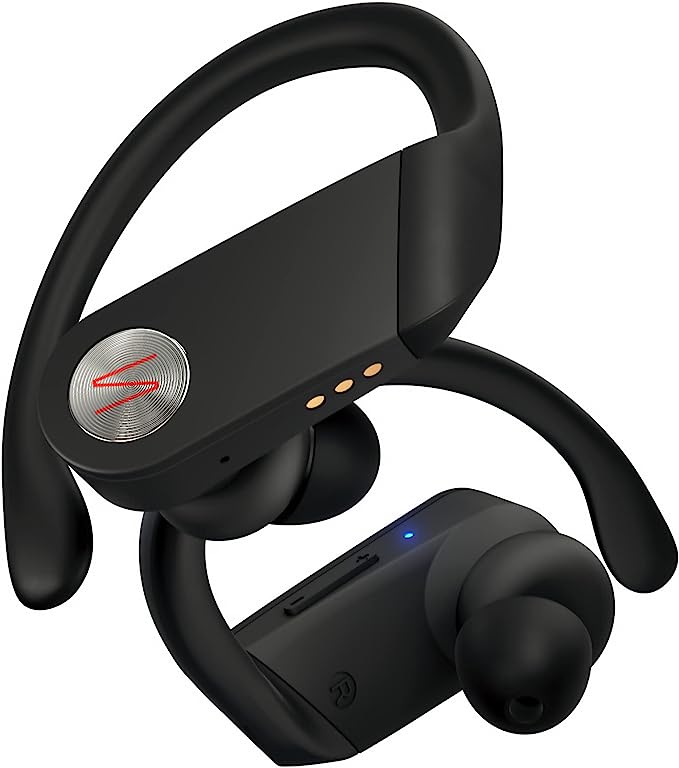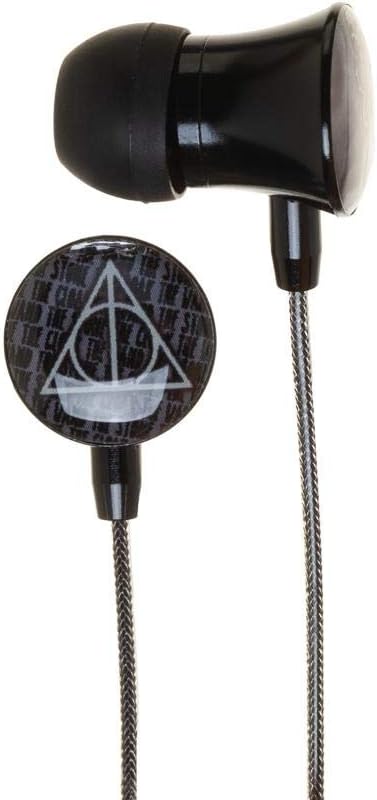Deeprio DK001 Wireless Headphones: The Science of Secure Fit & Stereo Sound for Your Active Life
Update on April 28, 2025, 3:14 p.m.
We’ve all been there. You’re pounding the pavement, lost in the rhythm, maybe hitting a new personal best, when bam – an earbud works its way loose, dangling precariously or worse, hitting the ground. It’s more than annoying; it breaks your focus, disrupts your flow. For anyone who loves moving to music, keeping those tiny sound-blasters securely in place while battling motion, impact, and the inevitable sweat is challenge number one.
Designing earbuds, especially affordable ones aimed at active users like the Deeprio DK001 Wireless Headphones, isn’t just about stuffing electronics into a small shell. It’s an intricate puzzle involving physics, ergonomics, material science, and acoustic engineering. It’s about making deliberate choices to solve real-world problems. So, let’s put on our metaphorical lab coats and peek under the hood of these earbuds. Forget the marketing hype for a moment; let’s explore the science and engineering thinking that aims to make your workout soundtrack uninterrupted.

Solving the Slip: The Physics and Ergonomics of a Secure Fit
The first hurdle for any sports earbud is simple, yet profound: staying put. Gravity is relentless, the impact of your feet hitting the ground sends jolts through your body, and sweat acts like a surprisingly effective lubricant trying to ease those buds right out of your ears. How does the Deeprio DK001 attempt to counteract these forces? It employs a three-pronged strategy rooted in basic physics and human-centric design (ergonomics).
First, you’ll notice the Over Ear form factor featuring soft ear hooks. This isn’t just for looks. Think of it like the arms on a pair of eyeglasses. These hooks utilize the sturdy structure of your outer ear (the pinna) as an anchor point. From a mechanics perspective, this creates a much more stable “lock” than relying solely on friction inside the ear canal. It’s a simple lever and anchor system working to counteract the downward pull and jarring motions.
Second, the design goes In-Ear, relying on silicone eartips to form a seal within your ear canal. Crucially, Deeprio provides three different sizes. Why? Because human ears are incredibly varied. Finding the right tip size is vital not just for comfort, but for stability. A snug (but not painfully tight) seal maximizes contact area, increasing the friction that holds the earbud in place. It also has an acoustic benefit we’ll touch on later. It’s a nod to personalization, acknowledging that a one-size-fits-all approach rarely works well when dealing with the human body.
Third is the subtle factor of weight. The description mentions the buds weigh only 9 grams. While that sounds tiny (and it is – roughly the weight of two US nickel coins), in the world of physics, mass matters. Newton’s second law (Force = Mass x Acceleration) tells us that for a given jolt or acceleration, a lighter object requires less force to keep it moving along with your head, rather than being left behind or shaken loose. Lower mass means lower inertia, making the earbuds less susceptible to being dislodged by sudden movements or the repetitive impact of running.
So, that secure fit isn’t magic. It’s a calculated combination: the mechanical anchoring of the ear hooks, the customizable friction seal of the eartips, and the physical advantage of low mass. It’s applied science aiming to solve a common frustration.

The Soundtrack to Your Stride: Decoding the Audio Experience
Okay, assuming the earbuds are now firmly in place, what about the sound fueling your workout? The DK001 promises Hifi Stereo Sound, driven by a relatively large 13mm dynamic driver in each earbud. Let’s unpack that.
At its core, a dynamic driver works much like a traditional loudspeaker, just miniaturized. An electrical signal representing the music flows through a voice coil attached to a diaphragm (a thin membrane). This coil sits in a magnetic field. The changing electrical current makes the coil and diaphragm vibrate rapidly, pushing air back and forth to create the sound waves your ear perceives.
The description highlights the 13mm size, claiming it’s significantly larger than many competitors. In acoustics, all else being equal, a larger diaphragm has the potential to move more air. Moving more air is particularly important for reproducing low-frequency sounds – the bass and sub-bass that often provide the driving beat in workout playlists. This physical principle is likely why Deeprio emphasizes “deep bass” and “full and balanced sound.” However, “Hifi” (High Fidelity) is a broad term, and the final sound signature depends heavily on the driver material, enclosure design, and especially the electronic “tuning” – how the manufacturer shapes the frequency response. The 13mm driver provides the potential, but the actual listening experience is subjective. The key takeaway is the stereo aspect: separate audio channels for left and right ears create an immersive soundscape, making music feel more spacious and engaging than single-channel mono sound.

Beyond music, practicality matters. Each earbud includes a built-in microphone. While the description claims “crystal clear phone calls,” the actual performance depends on the microphone quality and any background noise reduction algorithms (which aren’t detailed). Still, having mics means you can take a quick call without pulling out your phone – a handy feature when you’re mid-stride or mid-set.
Furthermore, the DK001 offers Stereo/Mono Modes. This means you can use just one earbud independently while the other stays in the case (perhaps charging) or simply off. Why is this useful? Two key reasons: Situational Awareness – crucial for safety when running or cycling outdoors, allowing you to hear traffic or other ambient sounds. Practicality – you can effectively double your listening time by using one bud while the other recharges, or simply share an earbud with a workout partner (though audio quality will be mono for each person). It’s a flexible design choice catering to different user needs.
Sweat Happens: Understanding IPX5 and Durability
Exercise generates heat, and the body cools itself with sweat. Electronics, generally, do not appreciate moisture. Add the possibility of getting caught in light rain, and suddenly, durability becomes a major concern. The Deeprio DK001 addresses this with an IPX5 rating. What does this code actually mean?
“IP” stands for Ingress Protection. It’s a standardized rating system defining how well an electrical enclosure resists intrusion from solids (like dust) and liquids. The first digit after IP relates to solid protection. Here, it’s an ‘X’, which means the earbuds haven’t been specifically rated for dust ingress according to the standard testing procedure.
The second digit, ‘5’, is the crucial one for liquids. An IPX5 rating signifies that the device is protected against low-pressure water jets projected from any direction. Think of it like surviving a splash from a faucet or being sprayed lightly with a hose.
What does this mean in the real world for the DK001? It means they are designed to withstand the sweat generated during intense workouts (“complete sweat protection,” as Deeprio puts it) and should handle being caught in light rain without issue. This level of protection is generally sufficient for most running, gym, and everyday active use scenarios. However, IPX5 is not fully waterproof. These earbuds are not designed to be submerged in water – so no swimming, showering, or dropping them in a puddle and expecting them to survive unscathed. It’s like the difference between a water-resistant watch you can wear while washing your hands, and a dive watch built for deep-sea exploration. Knowing the rating helps set realistic expectations for their durability.

Cutting the Cord, Simplifying Control: Wireless Life & Interaction
The final piece of the puzzle is making the whole experience seamless and unobtrusive, letting you focus on your activity, not on fiddling with your gear. This involves connectivity, battery life, and controls.
The DK001 uses Bluetooth to connect wirelessly to your phone, laptop, or other devices. The accompanying “A+ content” description mentions an “Advanced Bluetooth 5.0 chip set,” which generally aims for improvements in range, connection stability, and power efficiency compared to older Bluetooth versions. While the official description claims a “no-barrier 33 ft stable connection,” a user Q&A response suggests a more conservative practical range of “About 15ft (5m).” Bluetooth range can be affected by many factors (walls, interference, the paired device), but the core benefit is freedom from wires. The “Easy Pairing” feature further enhances convenience – simply taking the earbuds out of their charging case should automatically turn them on and connect them to your last paired device.
Powering these wireless buds requires batteries. Each earbud holds enough charge for up to 5 hours of continuous playback. The compact charging case carries its own battery, providing an additional 20 hours of charge. This means you get a total of roughly 25 hours of listening time before needing to plug the case itself in – likely enough for a week’s worth of workouts or commutes for many users. When it is time to recharge the case, it uses a modern USB-C port, which is increasingly standard and often offers faster charging (though the specific charging speed isn’t mentioned).
Finally, managing your music and calls mid-activity needs to be easy. The DK001 incorporates Smart Touch Controls on the buds themselves. These likely use capacitive sensing (detecting the touch of your finger). Simple taps allow you to play/pause, skip tracks, adjust volume, answer or reject calls, and hang up – all without reaching for your phone. They are also compatible with Google Assistant and Siri, allowing you to activate your phone’s voice assistant directly from the earbuds for hands-free commands. This focus on on-bud control minimizes distractions, keeping you in the zone.

The Sum of Its Parts – Engineering for the Everyday Athlete
Looking at the Deeprio DK001 through a scientific lens reveals more than just a list of features. It shows a series of considered engineering choices aimed squarely at the challenges faced by active users. The secure fit isn’t just comfortable; it’s applied physics and ergonomics battling inertia and gravity. The sound system leverages basic acoustic principles within budget constraints. The IPX5 rating provides a defined level of protection against the elements encountered during exercise. And the wireless connectivity and controls are designed to minimize friction and maximize convenience.
For its accessible price point (listed at $16.99 at the time of writing), the DK001 package attempts to deliver a specific set of solutions tailored to runners, gym-goers, and anyone who wants music to accompany their movement without hassle. Understanding the ‘why’ behind the ear hooks, the driver size, the IP rating, and the auto-pairing doesn’t just demystify the technology; it empowers us as users. It helps us appreciate the blend of science and design woven into even everyday gadgets, allowing us to make more informed choices and perhaps, enjoy that workout soundtrack just a little bit more, knowing how it all works.



























































